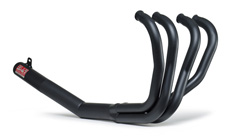
Your exhaust needs to match your
bike and your riding style
Your bike is a finely tuned piece of engineering with everything working together to give you precise handling, poised braking and immediate power when you ask for it. If you upset that balance you won’t get the best out of it, so when you’re buying a new exhaust you need one that suits your bike and your riding style.
It’s important that any aftermarket component, particularly one as important as an exhaust, works with your bike and not against it. So you’ll also need to get a couple of other minor components to ensure your new exhaust works in harmony with your bike for peak performance.
Yoshimura has been making performance exhausts and other power-producing components for over 55 years and its teams and riders have won countless races (including the blue riband Daytona 200) and over 30 – yes thirty – AMA, WORCS and GNCC titles since 1999 alone! What they don’t know about exhaust systems isn’t worth knowing, so we turned to their expertise and created our guide to buying a new exhaust.
Full Exhaust System or Slip-On Exhausts?

Slip-ons replace the old muffler section and bolt
directly to a bike’s existing exhaust system
The full exhaust provides better medium and top-end power for riders who often have their hand cranked all the way to the throttle stops. Anyone favoring track days or cruising longer distances will benefit from a full exhaust system.
The slip-on is better for instant low-end power and ‘stop-go’ city riding. Adding performance at low RPMs the slip-on is ideal for riders who want a bit more speed when the traffic signals turn green. The 3/4 pipe falls somewhere between the full and slip-on systems in performance characteristics.
Making Exhaust and Bike Work Together
A new exhaust changes the airflow of a bike’s engine and Yoshimura (and the other exhaust specialists) recommend that when fitting a new exhaust an engine management system is also installed.EFI (electronic fuel injection) management will ensure the correct amount of fuel is delivered for the corresponding airflow the exhaust is generating. Changing the airflow but not changing the gas delivery will result in exhaust and engine not working together and a noticeable drop in performance.

A full system exhaust is a complete
replacement from engine block to tailpipe
It’s also a wise move to upgrade the air cleaner or at the very least change the filter. Your new exhaust will be sucking more air through the engine and you want the air cleaning system to be able to handle that additional airflow. Don’t spend your hard earned cash on a new exhaust only to strangle its potential by denying it the air it needs.
By John Bone